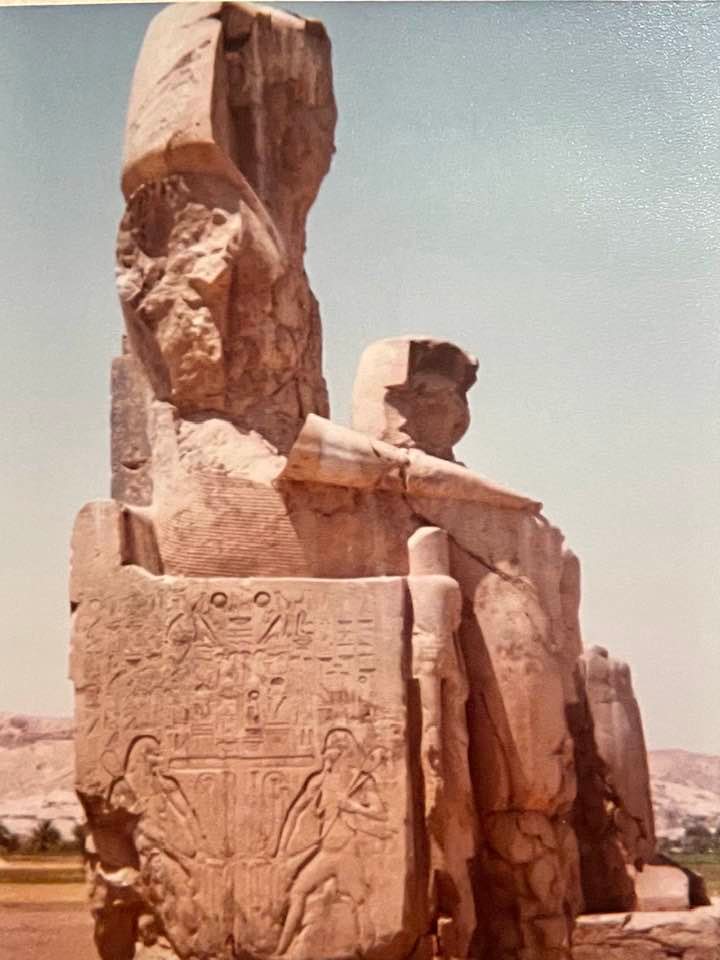MARCH 5, 2022 – If Australia’s Outback was hotter than Hades, the Egyptian desert was hotter yet. After standing for five minutes on sunbaked sand, I felt it burn through the soles of my Nikes. The most welcome hawkers I’d ever seen were the water vendors near the entrance to King Tut’s tomb. Not in any marathon had I absorbed a liter of H2O so quickly.
Once fully hydrated I remembered why I’d ventured into the desert. “The work of the ancient dynasties impressed me more than I’d expected,” I wrote home. “The tombs, temples, and colossi at Luxor shouldn’t be missed by anyone even remotely interested in ancient art and architecture. The tombs at the Valley of the Kings were especially spectacular.
“Since the wall paintings haven’t been exposed to the elements, they are remarkably well preserved. Some appear to have been executed just yesterday. The most impressive aspect of these works is that they are ‘on location’ and not in some stuffy, sterile museum.
“[You’d] flip out over the tomb of King Tutankhamun. There at the base of the funereal staircase was the source of all that gold treasure. And still in the tomb is the sarcophagus, one of the gold ‘caskets’ and the mummy. The frescoes were the most artful [you could imagine].”
On another day, my two Kiwi friends and I rented bicycles, and before the heat rose to 400 degrees (it seemed), we pedaled to the Colossi of Memnon, completed in 1350 BCE—and featured among Professor Beam’s slides back at Bowdoin. Sixty feet in height, the statues guarding the mortuary temple (long reduced to ruins) of Amenhotep III have been severely damaged by irrepressible time. As I gazed upon the two Colossi in the complete silence of our surroundings, I recalled Shelley’s poem, Ozymandias, (Greek for Pharaoh Ramesses II (a century after Amenhotep III)).
On the same day—staying well-hydrated—we biked to the Temple of Queen Hatshepsut, who reigned the century before Amenhotep III. She was fifth Pharaoh of the 18th Dynasty . . . as would be (theoretically) remembered from Professor Beam’s brilliant lectures.
Within a panoramic view of the temple, we were accosted by a bevy of hucksters. Among them were “entry-level” con-artists attempting to sell us shards of baked mud bearing crude hieroglyphs from the Thutmosid Dynasty (to which Hatshepsut, her four predecessors and King Tut belonged). These striving fraudsters would pull us aside, feign caution, and make a furtive show of “ancient artifacts” hidden in the folds of their robes.
Then followed the practiced lines: “I sell you rare piece from temple—cheap price! But you not tell anyone because very illegal!” To humor Simon and Julie (the Kiwis), I haggled with several “shard-hawkers” but never to the buying point. If my disingenuousness was uncharitable, it was a notch above attempted fraud by the aspiring conmen.
Of much greater reward was our later hire of a Nile boatman aboard his ancient lateen rig. Light breaths of desert air coaxed the boat across the great river toward an exhausted, reclining sun.
(Remember to subscribe to this blog and receive notifications of new posts by email.)
© 2022 by Eric Nilsson
